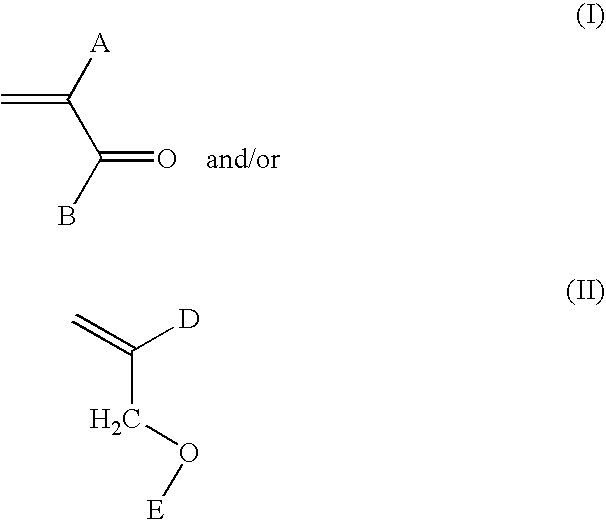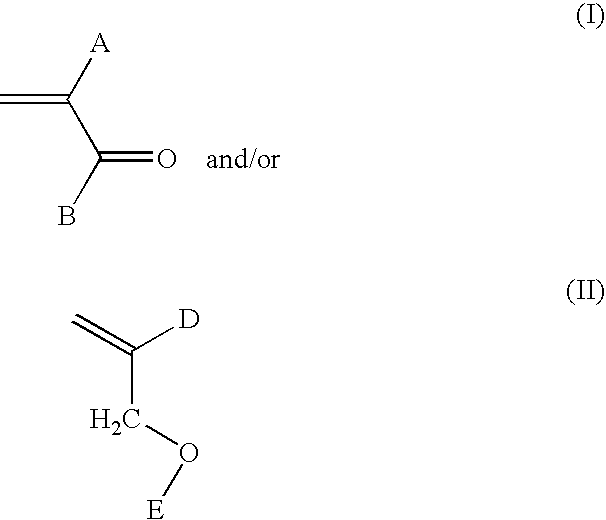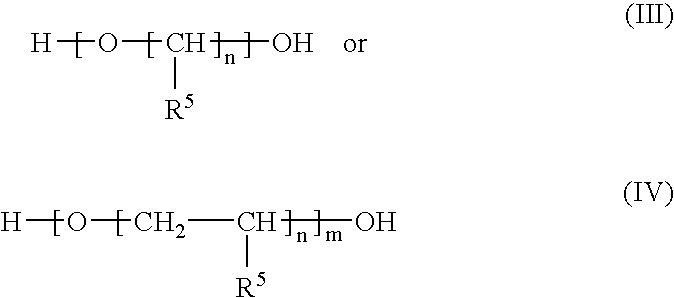Coating compositions containing polyurethane dispersions and highly crosslinked polymer particles
- Summary
- Abstract
- Description
- Claims
- Application Information
AI Technical Summary
Benefits of technology
Problems solved by technology
Method used
Image
Examples
examples 1 – 8
EXAMPLES 1–8
[0217]The following Examples 1 through 8 describe the preparation of highly crosslinked aqueous dispersions. Examples 2, 3, 4, 7 and 8 are comparative examples having lower levels of crosslinking monomers and / or hydrophilic monomers. The aqueous dispersions were prepared as described below from the following ingredients. Amounts listed below indicate parts by weight (grams) unless otherwise noted.
[0218]
Ex. 1Ex. 2Ex. 3Ex. 4Ex. 5Ex. 6Ex. 7Charge 1Deionized water991.8592.5592.5592.5596.9596.9596.9Dioctyl1.50.90.90.90.90.90.9sulfousuccinate1Feed AMethyl methacrylate15.69.39.39.39.39.39.3Butyl acrylate8.24.94.94.94.94.94.9Ethylene glycol12.07.27.27.27.27.27.2DimethacrylateFeed BDeionized water39.229.529.529.529.529.529.54,4'-Azobis4.02.42.42.42.42.42.4(4-cyanopentanoicacid)Dimethylethanol3.62.22.22.22.22.22.2amineFeed CMethyl methacrylate296.4194.7211.4228.1186.2194.6203.0Butyl acrylate279.9183.7200.4217.0175.1183.5191.9Ethylene glycol222.4100.066.633.3133.8133.8133.8Dimethac...
example 8
[0220]This example describes the preparation of an aqueous polyurethane dispersion containing polyurethane-acrylate particles dispersed in an aqueous medium of the present invention.
example 8a
[0221]Preparation of an active hydrogen-containing polyurethane acrylate prepolymer. A latex containing a hydrophilic polyurethane prepolymer was prepared by adding 313.3 g of N-methyl pyrrolidine, 234.4 g of hydroxyethyl methacrylate, 241.5 g of dimethylol proprionic acid, 2.3 g of 2,6-Di-tert-butyl 4-methyl phenol, 2.3 g of triphenyl phosphite, and 2.3 g of dibutyl tin dilaurate to a four necked round bottom flask fitted with a thermocouple, mechanical stirrer, and condenser and heated to 100° C. in to obtain a homogeneous solution. Then 1200.0 g of polytetrahydrofuran molecular weight 1000 was added. To this mixture at 90 to 100° C., isophorone diisocyanate 666.9 g was added over 90 minutes. The isocyanate container was rinsed with 153.0 g of butyl acrylate. The reaction mixture was stirred at 90° C. until all the isocyanate groups were reacted. Then 1100.0 g of butyl acrylate was added and cooled to ambient temperature. Based on the ratios of monomers used, the theoretical distr...
PUM
| Property | Measurement | Unit |
|---|---|---|
| Percent by mass | aaaaa | aaaaa |
| Percent by mass | aaaaa | aaaaa |
| Percent by mass | aaaaa | aaaaa |
Abstract
Description
Claims
Application Information
 Login to view more
Login to view more - R&D Engineer
- R&D Manager
- IP Professional
- Industry Leading Data Capabilities
- Powerful AI technology
- Patent DNA Extraction
Browse by: Latest US Patents, China's latest patents, Technical Efficacy Thesaurus, Application Domain, Technology Topic.
© 2024 PatSnap. All rights reserved.Legal|Privacy policy|Modern Slavery Act Transparency Statement|Sitemap



